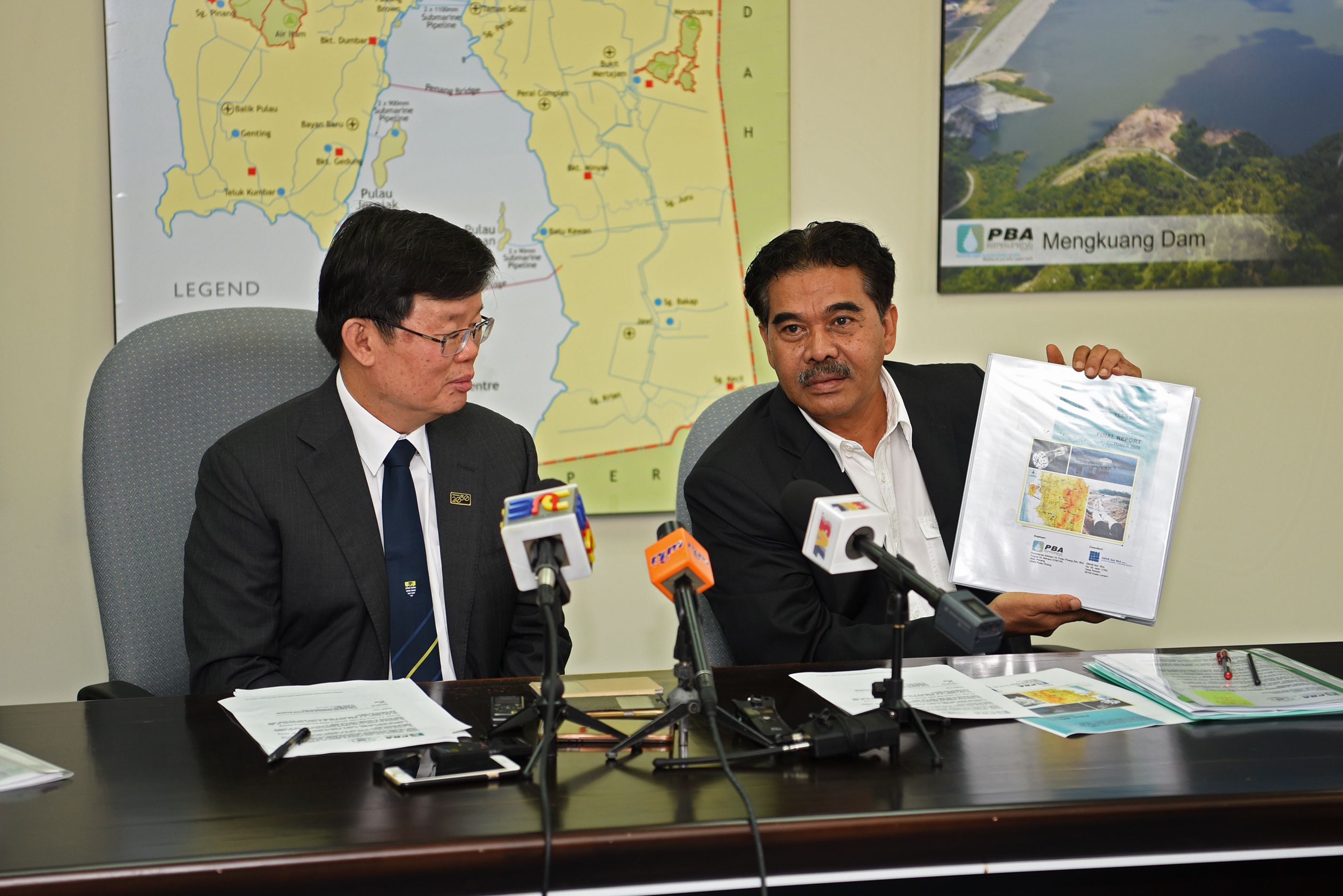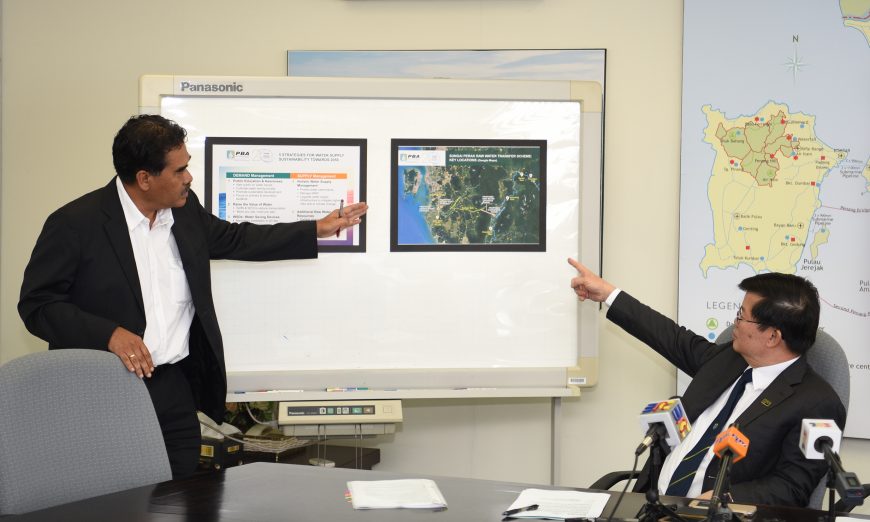PENANG has been working towards water supply security until 2050, based on the recommendations of a master plan study.
Penang Water Supply Corporation (PBAPP) chief executive officer Datuk Jaseni Maidinsa said PBAPP has been working on the strategies arising from the master plan for the last 10 years to ensure the state has enough water supply, including avoidance of water rationing.
“Penang has achieved a water reserve margin of 32.9% in 2018. This is the highest and safest margin in Malaysia. The national average margin was 14.3% in 2017. And this is only possible if we’ve a master plan,” Jaseni told reporters at Komtar today.
Jaseni was holding the press conference in the presence of Chief Minister Chow Kon Yeow to dismiss allegations made by an Aliran report that the state has no water master plan, no comprehensive long-term plan to manage its water supply and promote water security, no follow-up on its campaign to save Ulu Muda (the water catchment for Sungai Muda) and has downplayed water security.
“This is how thick the 2009 master plan report is,” Jaseni showed pressmen the bundled documents to counter allegations made on March 26 by Aliran in a report entitled “Penang needs PWMP (Penang Water Master Plan) more than PTMP (Penang Transport Master Plan).”
“Our master plan report has been distributed to federal agencies, ministries, our regulator, Perak, SPAN and the Northern Corridor International Agency.
“We want to tell the truth so that people can compare when they said and what we said.”
He said in 2009, PBAPP commissioned an independent “Masterplan Study for Potable Water Supply in Penang until Year 2050”. This study projected Penang’s treated water demand to be 1,483 million litres per day (MLD) by 2030; 1,696 MLD by 2040 and 1,884 MLD by 2050.
The study noted that about 80% of Penang’s raw water was derived from Sungai Muda, and there was a need to reduce such heavy dependence from a single source.
Jaseni said the study proposed the implementation of the Sungai Perak Raw Water Transfer Scheme (SPRWTS) to tap a second major raw water resource for Penang.
“Since 2011, the Penang government and PBAPP have been pursuing the implementation of the SPRWTS, not only for the benefit of Penang, but also for the benefit of Northern Perak.
“However, the previous Federal Government did not do anything about the Sungai Perak scheme in the period 2012-2018. So now, with the new Federal Government, the Penang government and PBAPP will be pursuing the matter.”

He added that the Ministry of Water, Land and Natural Resources (KATS) called for Perak and Penang to seek a “win-win” solution on tapping Sungai Perak as a raw water resource.
“In 2019, KATS has taken the lead in hosting talks between Perak and Penang in Putrajaya. KATS is now commissioning technical studies to determine the best way to implement this inter-state water transfer scheme.”
For Penang, Jaseni said the potential maximum raw water yield from SPRWTS is 1,000 MLD.
In 2018, PBAPP produced 1,073 MLD of treated water per day by abstracting raw water from Sungai Muda and other raw water resources in Penang.
“The projected water demand for Penang in 2050 is 1,884 MLD. As such, due to its promising potential yield, the SPRWTS may ensure water supply security for Penang until Year 2050.”
Jaseni added that it was also wrong to criticise that Penang has downplayed water security issue as PBAPP has been issuing many press statements.
Telling the media to check their archive, he said in the period 2016- 2018, PBAPP had issued 63 mass media releases on key water supply issues and developments in Penang and the northern region, including 15 releases referring specifically to Ulu Muda and Sungai Muda.
Besides that, he said PBAPP has also been actively posting water supply news on social media via Facebook and updating the effective capacities of Penang’s dams regularly on www.pba.com.my for public reference.
From 2008 to 2018, PBAPP invested RM682.6 million in water supply engineering projects in Penang.
On Jan 14 this year, PBAPP issued a media release stating that it was planning to invest a total of RM501 million in water supply projects in the period 2019 – 2021, for the benefit of Penang.
Jaseni said that PBAPP had also issued media release on Oct 23, 2018 proposing measures to protect Ulu Muda as a “Northern Region Water Catchment Area” in perpetuity.
PBAPP also proposed that a Federal department be established to monitor and manage Ulu Muda, not only as a rainforest area, but as a regional water catchment area; and provide Federal compensation to Kedah to conserve Ulu Muda, not only for Kedah, but for Perlis and Penang as well.
These proposals, Jaseni added, have also been tabled in meetings and communiques with KATS and the National Water Resources Council (MSAN).
Last year, the Kedah government finally agreed to ban logging in Ulu Muda rainforest area. It is the water catchment area for Sungai Muda, which presently serves as Penang’s one and only primary raw water source.
“In fact, after Penang and PBAPP had highlighted the importance of Ulu Muda as a regional raw water resource, logging was banned in its precious rainforests.
“Penang and PBAPP would like Ulu Muda to be properly conserved and protected for perpetuity. However, since Ulu Muda is in Kedah, the onus is on the Federal Government to work with Kedah to carry out the necessary actions.
“So, it is untrue that “nothing was said about Ulu Muda” after the Penang’s World Water Day 2018 commemoration on June 23 last year,” Jaseni explained.
Story by K.H. Ong
Pix by Ahmad Adil Muhamad
Video by Noor Siti Nabilah Noorazis

